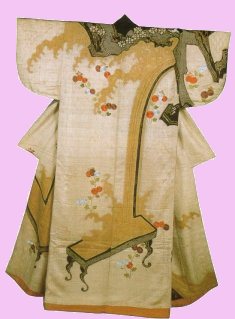
Kimono History: The Edo period
This period ended with the rule of Tokugawa Ieyasu. His capital city was Edo, which became modern-day Tokyo. He basically isolated Japan from most foreign influences. Thus began the Edo period of Japanese history.
The Edo period is divided into three sections: the early Edo from 1615 to the end of the 17th century; the middle Edo period, or the 18th century, and the late Edo period, 1800 to 1868.

This is from the early part of the Edo period, around the mid-seventeenth century. It is possible that some parts of this kimono may have been added later. The chrysanthemum flower is one of the parts that might have been added later, along with some type of reworking of the sleeves.

This is an example of the Kanbun style of composition where the central design is concentrated on the right side of the body around the shoulder area. This is another kimono which was apparently altered; in this case it was probably taken apart, perhaps used as temple cloths, and then put back together to try to resemble the original as much as possible.
During the late Edo period the art of the kimono began to decline as inspiration in their design seemed to be lacking, and older designs were just repeated.
Yuzen dyeing dates back to this period. This uses a rice-paste resist. It might come from Miyazaki Yuzen, a Kyoto painter. It is possible, though, that he is not the one that came up with the process but instead was the person who made the process popular. In making the design the person first draws a picture or other graphic design on the cloth with juice squeezed from spiderworts. The patterned cloth is then taken apart and attached to the kimono itself. The outline of the picture is starched with rice paste so the dyes do not bleed. Soybean juice is brushed onto the kimono cloth to ensure a good dye. Then colors are brushed into the shaded and floral design areas. The cloth is steamed at a hundred degrees Celsius for forty minutes. Even more work may be done before the kimono is finally finished.
Yuzen dyeing allowed complex images to be made, leading to more realistic pictorial designs.
The obi became more important during this period. The obi is the sash worn around the waist. Before this it was a narrow band of cloth, but after the mid-17thcentury this changed. This might have come about because a popular kabuki actor, Uemura Kichiya, appeared wearing a wide and long obi tied in a bow although it could also have come about for other reasons
During this time high-ranking samurai wore upper garments over the kimono and also wore hakama. Later scholars and wealthy men adopted this form of dress. The kosode became even more popular, again with fads playing a major role. The fashions began to be influenced by what courtesans, entertainers and Kabuki actors wore, leading to more and more elaborate dress. The obi was kept simple in order to not distract from the appearance of the kimono itself.
Realizing the growing power of the merchant class, the shoguns enacted sumptuary laws to regulate expenditure on the extravagantly produced kosode.
Some of these include:
1. Controls on what clothes were appropriate for particular ranks and classes of people.
2. Controls on what occasions particular garments could be worn for.
3. Controls based on the age and gender of the wearer.
4. Peasants could not wear silk (not that they could afford to buy it, anyway)
5. If a child is born to a couple only the grandparents can give the child a dress made of cotton.
6. The light summer kimono could only be worn between May 15 and August 31. A lined garment was worn between April 1and May 15. A padded garment was worn between September 9 and March 31.
7. The Emperor worn ceremonial robes with large sleeves and a hakama which had twelve figures represented on it. Otherwise he wore grew and yellow when there was a pattern and green when there wasn't.
8. The retired Emperor wore a robe of liquorice yellow or silk dyed with a mixture of wood nut, called tsurubami.
9. Ministers of state wore garments of tea color with simple patterns.
10. Lords and nobles of the court word clothes of compound colors. Officials from the fourth rank up wore tea-colored clothes; fifth rank officials wore an undergarment of red; sixth rank officials deep green; seventh rank deep blue, and the lowest rank light blue.
Clever designs in the new paste-resist dying methods imitated prohibited techniques. This allowed people to acquire elaborately decorated garments without technically violating the sumptuary laws.

A kosode that actually belonged to Tokugawa Ieyasu which he gave to a troupe of Noh actors.
Other examples of Edo-period kimonos can be found here.
Main Index
Japan main page
Japanese-American Internment Camps index page
Japan and World War II index page
Back to start of kimono section
|